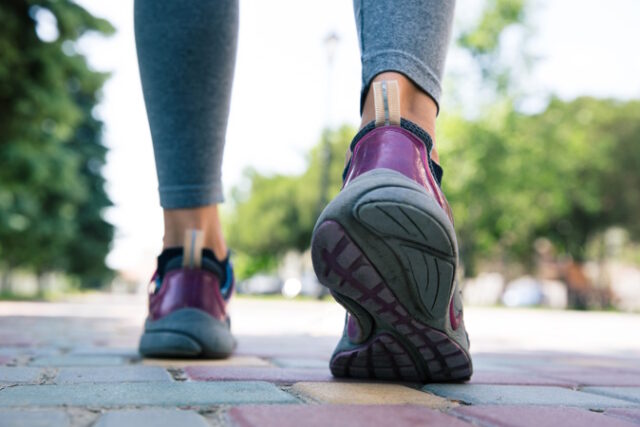
By Robby Berman — Fact checked by Ferdinand Lali, Ph.D.
Being sedentary for extended periods of time is considered to be unhealthy for anyone. It is of special concern for people with type 1 diabetes, since it is associated with the dysregulation of insulin levels.
At the same time, being too active can cause sudden, precipitous drops in blood sugar levels for people with type 1 diabetes.
A new study from the University of Sunderland in the United Kingdom demonstrates a middle ground, a way for people with type 1 diabetes to keep their blood sugar under control with safe, short periods of light-intensity walking. The authors call these “exercise snacks.”
The study finds that taking a 3-minute stroll after every 30 minutes of sedentary time helped study participants keep their blood sugar under control compared to people who were sedentary.
In addition, the researchers found that the light walking breaks did not put the participants at risk of sudden drops in blood glucose levels.
The researchers presented their recent findings at the Diabetes UK Professional Conference 2023. They also published a review drawing similar conclusions in the Canadian Journal of Diabetes.
The study involved 32 adults with type 1 diabetes and consisted of two sessions conducted over a period of 2 weeks.
In the first, participants remained seated for 7 hours. In the second, they got up every 30 minutes for a light 3-minute walk.
After each of the sessions, participants were outfitted with a continuous glucose monitor for 48 hours. During that period, researchers requested that they adhere to their standard insulin prescriptions and levels of activity. They also all ate a standardized breakfast and lunch.
The researchers found that after the short walks, individuals maintained a blood sugar average of 6.9 millimoles per liter (mmol/L). Their blood sugar levels were higher, 8.2 mmol/L, after the extended sitdowns.
Over 48 hours of monitoring, during and after the test period, the blood sugar levels remained in the target range by 14% higher in the participants who took exercise “snacks” compared to those who did not.
“This study is interesting,” commented Dr. Sumera Ahmed, an assistant professor at the College of Osteopathic Medicine at Touro University California, who was not involved in the study.
“[I]t is exciting to recognize that even frequent low-intensity and very short duration activities can help improve the time in range for people with type 1 diabetes. More importantly, it avoids hypoglycemia,” she noted.
Dr. Ahmed also pointed out that the study’s short strolls should be easy to incorporate into a person’s daily routine.
She also felt that the gentle impact of the exercise snacks would be unlikely to necessitate changes to their insulin doses or carbohydrate intake that might be required with more strenuous exercise.
While the study’s 7-hour sessions — with 14 short walks — are appropriate for a study trial, that is a lot of strolls for an average day, however.
“We need further studies to determine if [the] frequency of light intensity activities beyond the 30 minutes as noted in this study is beneficial, but anything more frequent than this may not be realistic or sustainable,” said Dr. Ahmed.
Endocrinologist Dr. Ana Maria Kausel, who was also not involved in the study noted: “I usually tell my patients to go for a walk after meals. There are some studies that have shown a reduction in blood glucose of 10 milligrams per deciliter (mg/dl) [7.2 mmol/L] per block they walk, regardless of the intensity.”
As this study demonstrates, light-intensity walks can keep blood sugar in range, and are safer than walking at higher intensities.
Dr. Ahmad described the blood glucose response of people with type 1 diabetes to physical activity as “highly variable,” depending on the type, intensity, timing, and duration of exercise.
“So these individuals require either additional carbohydrate intake or require insulin-dose adjustments before exercise is started,” she advised.
Dr. Kausel also cautioned:
“Type 1 diabetics are particularly very sensitive to exercise. [They] have to always be careful when doing physical activity. Ideally, all type 1 diabetics should be on a [continuous glucose monitor] during exercise.”
In type 1 diabetes, an individual’s pancreas fails to produce an adequate amount of insulin. Insulin is a hormone that allows glucose, or sugar, to enter the body’s cells where it is used as fuel for energy.
Without sufficient insulin, sugar becomes elevated in the bloodstream, where it can build up to unsafe levels.
Untreated type 1 diabetes can lead to serious complications, including eye and foot problems, heart disease, stroke, kidney disease, and nerve damage.
There is currently no cure for type 1 diabetes, and the ability of the pancreas to produce insulin tends to reduce further over time. One of the therapies being investigated is pancreatic islet transplantation, which may be able to replace low-functioning islets with new ones from a healthy donor.
Individuals with type 1 diabetes require multiple doses of insulin each day and must monitor their blood sugar to keep it within a safe range.
The primary daily concern is hypoglycemia. Symptoms of hypoglycemia include shaking, trembling, accelerated heart rate, dizziness or lightheadedness, headaches, nausea, hunger, anxiousness or irritability, restless sleep, weakness, and pale skin.
The worst outcome for those experiencing dangerously low blood sugar levels is going into a hypoglycemic coma and experiencing loss of consciousness.
This article originally appeared here and was republished with permission.












